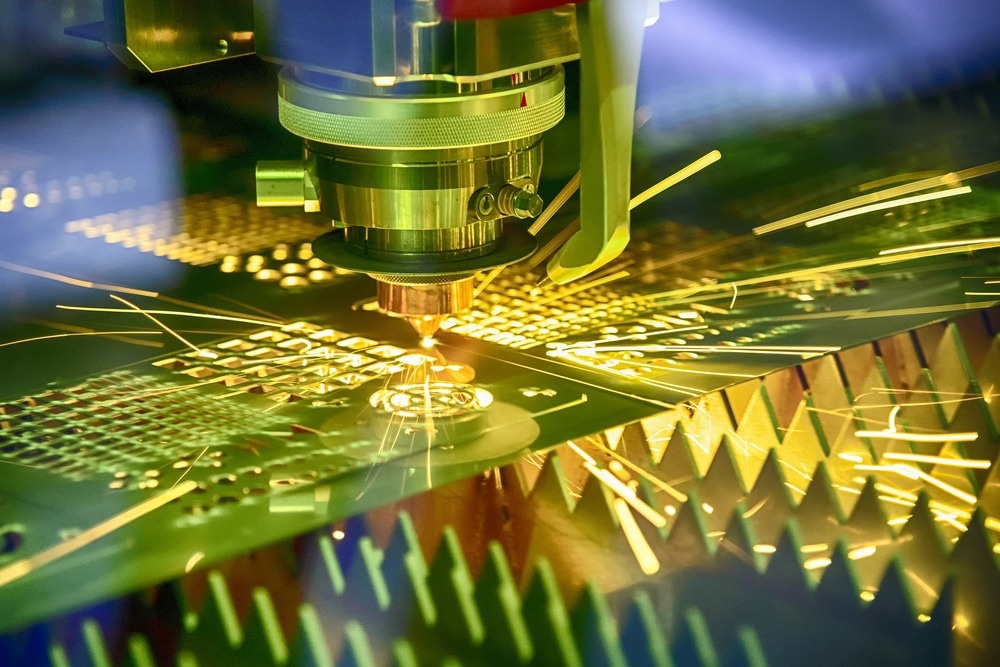In a study published in Nature Communications, researchers report the first comprehensive assessment of the frequency locking mechanism in breathers in ultrafast fiber lasers. The frequency-locked breathers can generate dense radio-frequency combs and exhibit a high signal-to-noise ratio (SNR), which is attractive for applications such as high-resolution spectroscopy.

Study: Farey tree and devil’s staircase of frequency-locked breathers in ultrafast lasers. Image Credit: Pixel B/Shutterstock.com
Frequency Locking in Nonlinear Systems
Nonlinear systems with two conflicting frequencies exhibit resonances or locking. The system locks into a periodic resonant response with a rational frequency ratio in this state.
The locking strengthens with increasing nonlinearity; at subcritical levels of nonlinearity, the system displays quasi-periodic reactions between locked states; at supercritical values of nonlinearity, the system may display chaotic in addition to periodic or quasi-periodic behaviors.
A common characteristic of frequency locking is the resistance of the locked states to changes in system parameters or the consistency of the applied frequency over a spectrum of parameters.
Frequency locking has been studied theoretically and experimentally in numerous physical systems, such as charge-density waves, coupled oscillators, the Van der Pol oscillator, and Josephson junctions. The Farey tree sequence from number theory demonstrates their distribution in parameter space in the devil’s staircase plot.
Frequency-locking phenomena are extensively employed in modulated semiconductor lasers because of their ability to couple an external frequency to the nonlinear system via a radio-frequency source, making it possible to easily observe the hierarchy of the Farey tree sequence and the structure of a devil’s staircase when tuning the external frequency.
Frequency Locking in Breathing Solitons
Most frequency-locking applications involve nonlinear systems that receive a new frequency from an externally precisely regulated modulator. Conversely, there is limited knowledge when the second frequency is modulated outside the nonlinear system.
This is noticeable in breathing solitons, which have only lately become the norm for ultra-short pulses in fiber lasers that are passively mode-locked. The breathing solitons are common in many branches of natural science, including fluid dynamics, solid-state physics, nonlinear optics, chemistry, plasma physics, and molecular biology.
From a practical application standpoint, breathers help increase the precision of dual-comb spectroscopy since the breathing frequency is combined with extra tones in a radio-frequency (RF) comb, and the breather laser can generate powerful ultra-short pulses without the need for compressors.
In addition to the difficulty presented by the lack of an external driver to achieve frequency locking, the stimulation of breathing solitons necessitates careful adjustment of the laser parameters because the breather’s mode-locking parameter space is much smaller than that of stationary mode-locking.
Therefore, it is challenging to target frequency-locked breather states in the ultrafast laser by conventional trial and error method.
Investigating the Dynamics of Frequency-Locked Breathers
This study used a laser cavity with practically negligible net dispersion. As in ultrafast lasers, dispersion plays a crucial role in defining pulse dynamics.
Fast and accurate laser tuning to the desired frequency-locked breather operation was made possible by the merit function utilized in the evolutionary algorithm (EA) optimization technique, which can differentiate between frequency-unlocked and locked breather states.
The dynamics of pulse evolution in optical fibers were modeled using the extended nonlinear Schrödinger equation. The numerical model was solved using a typical symmetric split-step propagation approach and parameters comparable to the nominal or approximated experimental values.
Significant Findings of the Study
A fiber laser operating in the range of breathing soliton production is a nonlinear system exhibiting frequency locking at Farey fractions.
Experiments and simulations demonstrate that the fractal dimension of the spiraling breathers approaches the devil’s staircase, proving the laser’s universal nature. Therefore, the frequency-locked breathers may be used as a basic model system to study the general dynamics of frequency locking.
The EA-based technique proposed for managing frequency locking in fiber lasers is not limited to nonlinear polarization evolution (NPE)-based setups. It can be extended to other laser frequency-locked systems, such as the Mamyshev oscillator.
Frequency-locked breathers generate radio-frequency (RF) combs that are not limited in width or density by the laser cavity’s length. Consequently, regulated frequency-locked breather lasers are desirable for several applications, such as high-resolution spectroscopy, since they provide an alternative to long unstable fiber cavities.
Frequency locking of breathers will not occur when the laser operates at a large or moderate normal dispersion. Therefore, the formation of frequency-locked breathers in a fiber laser depends on a very modest net cavity dispersion.
However, it is important to remember that breathing soliton with almost zero net and huge normal dispersion exhibit different oscillation periods. The latter often has a significantly longer duration of hundreds of round trips. In contrast, the former oscillates with a period varying from a few to dozens of round trips, suggesting that the underlying formation process may be distinct.
Reference
Wu, X., Zhang, Y., Peng, J, Peng, J., Boscolo, S., Finot, C., & Zeng, H. (2022) Farey tree and devil’s staircase of frequency-locked breathers in ultrafast lasers. Nature Communications. https://www.nature.com/articles/s41467-022-33525-0
Disclaimer: The views expressed here are those of the author expressed in their private capacity and do not necessarily represent the views of AZoM.com Limited T/A AZoNetwork the owner and operator of this website. This disclaimer forms part of the Terms and conditions of use of this website.